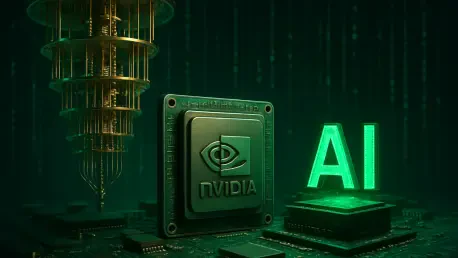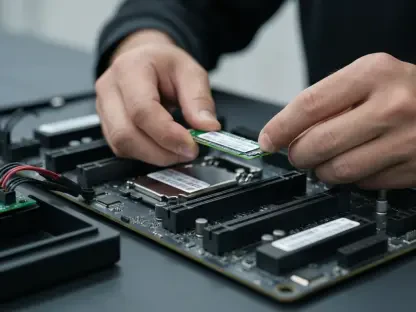In a world where technological advancements are reshaping industries at an unprecedented pace, Nvidia (NASDANVDA) has positioned itself as the linchpin of two transformative fields: artificial intelligence (AI) and quantum computing. As businesses, governments, and research institutions scramble to harness the power of AI for everything from autonomous vehicles to personalized healthcare, and as quantum computing promises to unlock solutions to previously unsolvable problems, Nvidia stands tall as the driving force behind these revolutions. With a unique blend of cutting-edge hardware, innovative software ecosystems, and a visionary approach to future technologies, Nvidia is not merely adapting to change but actively defining it. This exploration uncovers the strategic moves and financial might that have made Nvidia a standout in the tech landscape, offering a glimpse into why it is considered a vital investment for those looking to tap into the next decade of innovation and growth.
Shaping the AI Landscape with Unrivaled Infrastructure
Nvidia’s commanding presence in the AI sector is a testament to its ability to anticipate and meet the needs of a rapidly evolving market. The company’s Data Center segment has become a powerhouse, generating an astonishing $115.2 billion in revenue for fiscal 2025, marking a 142% increase compared to the prior year. This surge is largely attributed to the insatiable demand for Nvidia’s Blackwell AI supercomputers, which play a pivotal role in training large language models and enabling sophisticated AI applications across industries. These supercomputers have become indispensable for tech giants and startups alike, providing the computational muscle needed to push boundaries in machine learning and data analysis. By focusing on high-performance hardware tailored for AI workloads, Nvidia has created a foundation that supports the digital transformation sweeping through sectors like finance, healthcare, and entertainment, ensuring its relevance in an AI-driven world.
Beyond hardware, Nvidia’s software ecosystem amplifies its dominance by fostering deep integration with developers and enterprises. The CUDA platform, a critical tool for AI development, acts as a binding force that keeps users within Nvidia’s orbit, creating a near-unbreakable dependency on its technology. This strategic ecosystem not only drives innovation but also builds a competitive barrier, often described as a technological moat, that shields Nvidia from rivals. As AI workloads are projected to grow at a 30% compound annual growth rate through 2030, the company’s ability to maintain this developer loyalty will likely translate into sustained revenue streams. Moreover, Nvidia’s continuous updates to its software offerings ensure that it remains at the cutting edge, adapting to new AI methodologies and use cases, thus reinforcing its status as the backbone of modern AI infrastructure and a key player in shaping how industries leverage intelligent systems.
Breaking Ground in Quantum Computing Innovation
While Nvidia’s achievements in AI are widely recognized, its proactive steps into quantum computing reveal a commitment to staying ahead of the technological curve. Through the establishment of the NVIDIA Accelerated Quantum Research Center (NVAQC) in Boston, the company is spearheading efforts to explore and develop quantum solutions that could redefine computational capabilities. Tools like CUDA-QX, designed for hybrid quantum-classical computing, enable researchers to integrate quantum hardware with traditional systems, addressing complex challenges that classical computers cannot solve. This early investment in a field still in its infancy demonstrates Nvidia’s foresight in recognizing quantum computing’s potential to transform industries such as cryptography, material science, and drug discovery, positioning it as a pioneer ready to capitalize on future breakthroughs.
Equally significant is Nvidia’s approach to blending quantum advancements with its existing AI expertise to tackle immediate hurdles in quantum technology. One critical area of focus is error correction, a persistent challenge in quantum systems, where Nvidia leverages AI algorithms to enhance accuracy and reliability. By developing reference architectures like DGX Quantum and simulation toolkits such as cuQuantum, the company is building bridges between today’s computational frameworks and tomorrow’s quantum possibilities. Partnerships with quantum startups and major corporations further amplify Nvidia’s influence, ensuring that it remains embedded in the ecosystem as quantum computing matures. This strategic positioning not only prepares Nvidia for a leadership role in the quantum era but also underscores its dedication to solving foundational problems that will unlock the full potential of this emerging field for practical, real-world applications.
Financial Powerhouse Driving Technological Ambitions
Nvidia’s financial robustness provides the fuel for its ambitious endeavors in both AI and quantum computing, setting it apart as a titan in the tech industry. With a projected revenue of $43 billion for Q1 FY2026 and operating margins consistently exceeding 60%, the company demonstrates an extraordinary capacity to generate profit while scaling operations. A balance sheet reflecting $20 billion in cash reserves and negligible debt further empowers Nvidia to invest heavily in research and development without the constraints that burden many competitors. This financial flexibility is crucial for maintaining a relentless pace of innovation, allowing Nvidia to explore high-risk, high-reward areas like quantum computing while simultaneously expanding its AI offerings to meet growing market demands.
Analyst optimism surrounding Nvidia’s future adds another layer of confidence in its trajectory as a market leader. Projections suggest a potential market capitalization of $9 trillion by 2030, driven by an expected 30% share of the $2 trillion AI infrastructure market. This outlook is underpinned by Nvidia’s ability to consistently deliver high gross margins—hovering around 71%—which reflect efficient operations and strong pricing power in a competitive landscape. Such financial strength not only supports sustained investment in cutting-edge technologies but also offers resilience against potential risks like regulatory scrutiny or market fluctuations. For investors, Nvidia’s fiscal health translates into a compelling case for long-term growth, as it balances immediate returns from AI dominance with strategic bets on quantum advancements that could redefine the technological frontier in the years ahead.
Harnessing the Dual Power of AI and Quantum Synergy
Nvidia’s unique strength lies in the symbiotic relationship between its AI leadership and quantum computing aspirations, creating a dynamic cycle of innovation. The substantial cash flow generated from AI successes, particularly through the Data Center segment, provides the necessary resources to fund extensive quantum research and development. This financial backing allows Nvidia to explore uncharted territories in quantum hardware integration and simulation without the immediate pressure of profitability, setting the stage for future dominance. At the same time, the company’s established AI expertise offers a practical foundation for addressing quantum computing’s current limitations, such as error mitigation, ensuring that these two fields enhance each other in meaningful ways that competitors struggle to replicate.
This interplay creates a strategic advantage that mitigates risks and amplifies Nvidia’s market position across multiple technological domains. As quantum advancements promise to accelerate AI capabilities—potentially revolutionizing areas like optimization and predictive modeling—Nvidia’s early investments ensure it remains at the forefront of this convergence. The resulting flywheel effect, where AI fuels quantum progress and quantum breakthroughs enhance AI performance, establishes Nvidia as a central figure in shaping the future of computing. Despite challenges like competition from other chipmakers and cloud providers, Nvidia’s deep-rooted ecosystem, built on proprietary platforms and strategic alliances, offers a durable shield. This dual focus not only highlights Nvidia’s adaptability but also presents a rare opportunity for stakeholders to invest in a company poised to lead through multiple waves of technological disruption.
Reflecting on Nvidia’s Trailblazing Journey
Looking back, Nvidia’s journey reveals a remarkable transformation from a chipmaker to a visionary architect of next-generation computing. Its dominance in AI through record-breaking Data Center revenues and the Blackwell supercomputers showcases a mastery of current market needs, while early strides in quantum computing via research centers and hybrid tools illustrate a bold grasp of future possibilities. Financially, Nvidia’s robust margins and cash reserves underpin a relentless pursuit of innovation, balancing immediate gains with long-term bets. For those invested in technology’s evolution, the next steps involve closely monitoring how Nvidia navigates competitive pressures and regulatory landscapes while continuing to push boundaries in AI and quantum integration. Exploring partnerships and staying attuned to market demands will be critical as Nvidia builds on its legacy, offering a blueprint for how companies can lead through foresight and adaptability in an ever-changing digital era.









